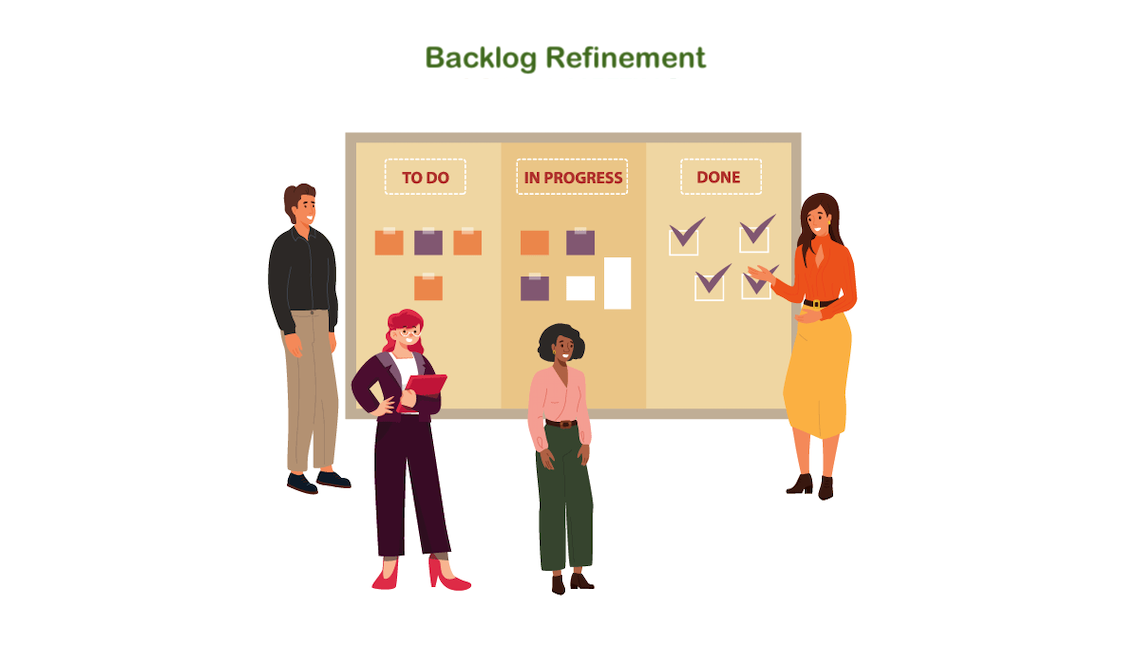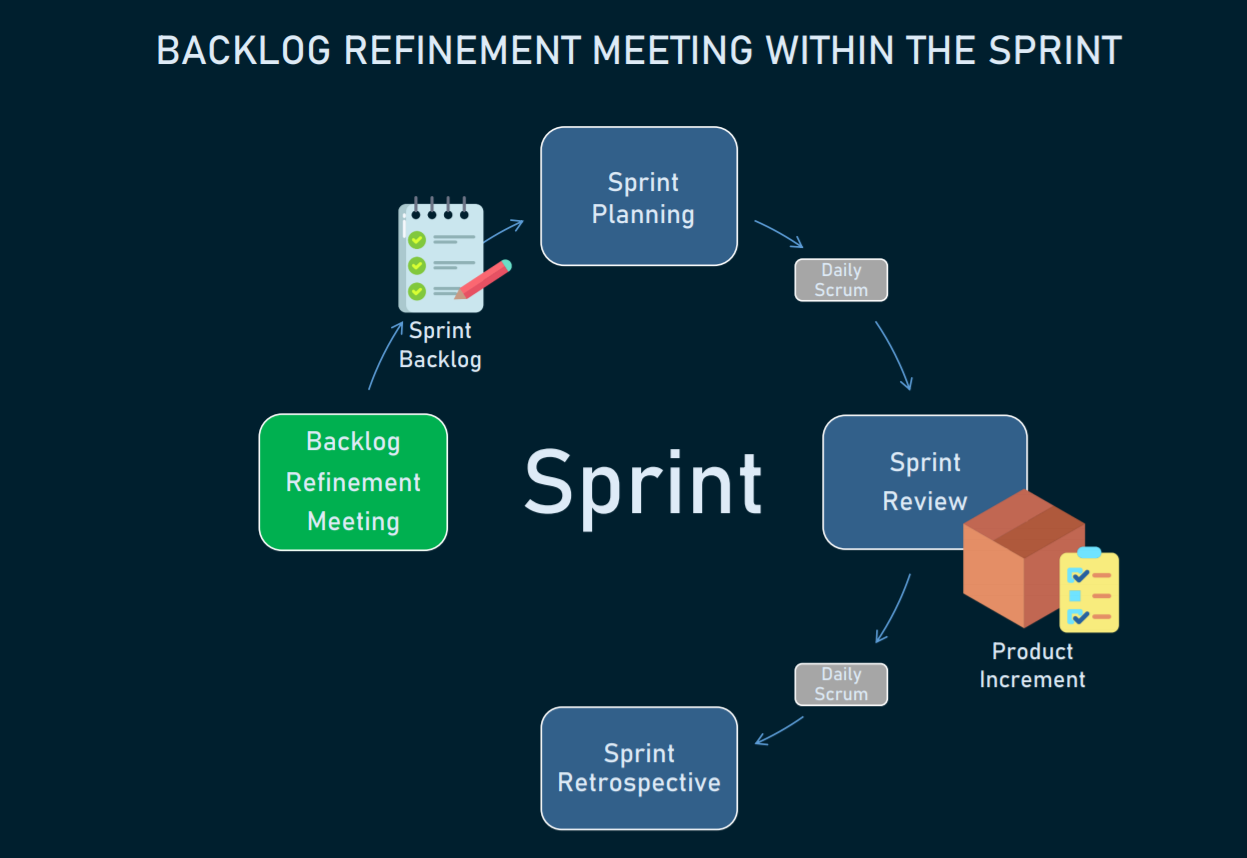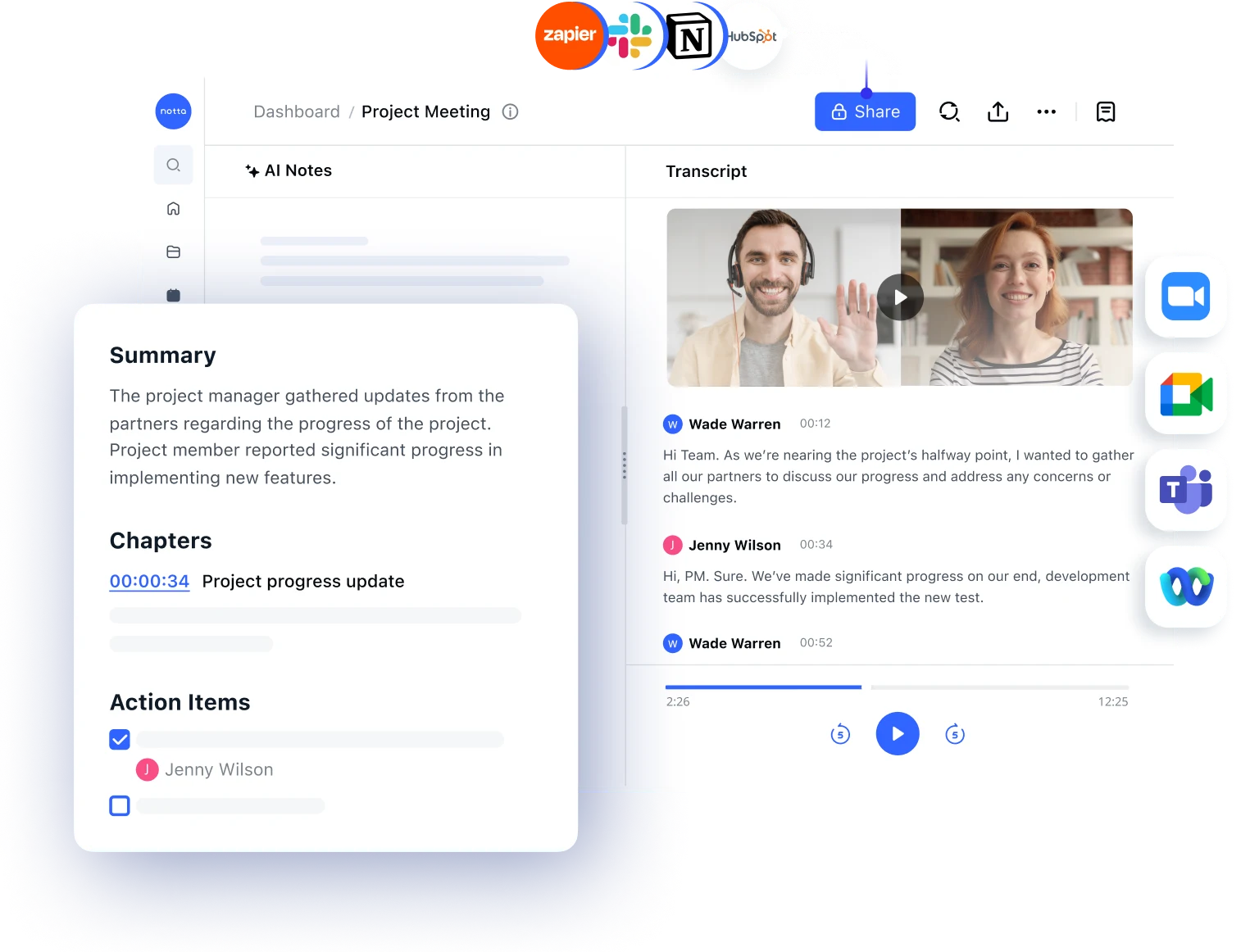Read more: 50+ Agile Statistics You Need to Know

How to Run Effective Backlog Refinement Meeting (+ Agenda)
Unlock the power of AI — Notta's meeting assistant records, transcribes and summarizes meeting minutes with one click.
Scrum is an agile framework that suggests building a product, usually software, in an incremental process based on Sprint. It divides the process into five formal events: Sprint Planning, Daily Scrum, Sprint Review, and Sprint Retrospective.
Backlog refinement is one event that is not listed but also plays a crucial part. It often takes place before Sprint Planning and involves breaking down the product backlog items into smaller and more manageable ones so that the Scrum Team has a clear view.
What is backlog refinement? Why does it matter to the Scrum Team? How do you prepare for and run this event effectively? Read on, and you will find all the answers in this guide.
We’ll also share a backlog refinement meeting agenda template that will help you prepare for your backlog refinement meetings.
What is backlog refinement in Scrum?
As defined by the Scrum Guide, product backlog refinement (formerly known as backlog grooming) is an ongoing process where the product owner (PO) and the development team review and organize the product backlog to ensure that it contains updated and appropriate items and that the items are properly prioritized.
A backlog refinement occurs on a regular basis and should perform the following tasks:
Reviewing backlog items and eliminating those that are no longer relevant
Coming up with new backlog items based on newly discovered needs
Re-evaluating the priority of items
Making estimates for new items and readjusting estimates for existing items
Splitting large items into smaller ones
Identifying backlog items that fit in the scope of an upcoming iteration
Identifying risks for items that will be implemented in the upcoming sprint iteration
The purpose of backlog refinement is to clean up the backlog and ensure that it only contains relevant and detailed items and their estimations and priority levels. It also ensures that all members have the same understanding of the items in the backlog and that everyone knows what they’ll be doing in the next sprint.

An added benefit of a backlog refinement session is that it facilitates knowledge transfer from the product owner to the rest of the team as the PO provides context about user stories, business models, and so on.
Backlog grooming vs. refinement
Backlog grooming and refinement mean the same thing. In the past, backlog refinement was referred to as backlog grooming. However, in 2013, The Scrum Guide dropped the word “grooming” in favor of “refinement” due to the negative connotations associated with the word “grooming.”
How often should the backlog refinement meeting occur?
The meeting frequency depends on your Sprint cycle.
Usually, the Scrum Team comes together once per Sprint, and for each Sprint, they will have a refinement meeting. For example, if your team is adopting a one-week Sprint cycle, then you should run a product backlog refinement meeting each week.
In the refinement session, the PO will share the current backlog items and discuss them with the whole team to refine them.
Key benefits of product backlog refinement
Product Backlog refinement is one of the core activities in Scrum and a key part of the agile methodology. Some of the reasons why it is important to hold refinement meetings include the following:
Clean up the product backlog
Over the course of development, several ideas and opinions get added to the product backlog. New user needs also get discovered, rendering some ideas irrelevant. With time, the product backlog becomes a messy collection of user stories, half-baked ideas, and outdated items.
Holding regular backlog grooming meetings helps clean up this mess, making it easier for the team to focus on what’s really important.
Keep the team updated
Product requirements and objectives will often change throughout the product development life cycle. A lack of proper channels for communicating these changes can lead to improper product decisions, implementation of the wrong decisions, and, ultimately, a product that doesn’t meet user needs.
Refining the product backlog keeps everyone updated on the changing needs and requirements and ensures that all team members are on the same page.
Improve Sprint Planning meetings
Backlog refinement meetings help define what will be implemented during the next sprint. This makes Sprint Planning meetings shorter and more efficient because they only need to focus on how the implantation will be done. All the other questions that would have arisen during sprint planning will already have been answered in the backlog refinement meeting.
Notta AI meeting assistant records, transcribes, and summarizes meetings so everyone can stay engaged without missing important details.
How to prepare for a backlog refinement (grooming)?
Before stepping into the backlog grooming session, the Scrum team, especially the product owner, should make some preparations to have an effective discussion.
1. Review the backlog items
In line with the overarching goals of the project, the product owner should first review all the product backlog items and remove the irrelevant ones as the user scenario or needs may change. Next, the PO should create new items based on the team’s discoveries from the previous sprint.
2. Prioritize the items with added details
Now the product owner has an ordered list of necessary backlog items, the next step is to prioritize these items based on the project needs so that the Scrum Team can focus on the user stories that bring the most business value.
Also, include all the necessary details for the high-priority items.
3. Create a meeting agenda
Rule #1 for running an effective meeting: never go to a meeting without an agenda.
The meeting organizer (most often the product owner) should create a meeting agenda and share it with the attendees in advance. This allows all participants to prepare their questions, related materials, and suggestions before the meeting. Having an agenda also helps focus on the important talking points and ensures that nothing gets forgotten during the meeting (we have listed an agenda template below).
How to run a backlog refinement session effectively
Now your Scrum Team is well prepared for backlog grooming. Here are some best practices that will help make your backlog refinement session more effective.
Make it DEEP
A well-managed backlog should be DEEP, which is an acronym for detailed appropriately, estimated, emergent, and prioritized.
Here, being detailed appropriately means that items with higher priority should have a higher level of detail than low-priority items. Estimated means you should have a good idea of the time and resources required to implement each backlog item. Emergent means that the backlog is a live document that should be updated regularly. Finally, the backlog items should be arranged in order of priority.
Keep customers in mind
Every decision made during the backlog refinement meeting should be based on customer needs. After all, if the product doesn’t work for your customers, nothing else matters.
The team will discuss the user stories openly to exchange ideas and finally get a common understanding.
Pro Tip: It’s recommended to document your discussions and thoughts so the PO can review them afterward and make a summary.
Notta is an AI meeting notetaker that can help record and transcribe all your conversations in real-time, whether online or in-person, so you can stay engaged in your discussion without worrying about missing any details or having disagreements later.

Identify dependencies
Sometimes, certain backlog items cannot be implemented until another item has been started or completed. Failure to identify these dependencies can lead to delayed progress down the line. Therefore, it’s good to identify these dependencies early and plan for them.
Follow up after the meeting
Once the meeting is over, follow up with all the attendees and share the minutes of the meeting with them. This helps keep everyone on the same page and ensures that they are aware of the next steps.
Also, if some user stories lack information, continue doing more research and add details for the next grooming meeting.
Notta offers the most integrated AI meeting notes, summaries, and action items so nothing gets missed.
Backlog refinement meeting agenda template
Before heading into a backlog refinement meeting, it’s wise to prepare an agenda to guide what will happen during the meeting. Having an agenda helps keep the backlog refinement meeting on track and helps team members prepare for the meeting ahead of time.
Here’s a sample meeting agenda template you can use for your backlog refinement sessions:
[Backlog refinement agenda]
Date:
Time:
Location:
Strategy review (3 minutes)
A quick review of the goals and objectives of the project
Incomplete tasks (5 minutes)
Identify tasks that were started in the previous sprint but did not get completed. Understand why they weren’t completed, and determine how these tasks will be incorporated into the next sprint.
What came up? (10 minutes)
Are there any new user needs, new features, or bugs that have come up since the last sprint? How important are they?
Key tasks for upcoming sprint (10 minutes)
In addition to any tasks that come up, go through the product backlog and determine the tasks to be tackled during the upcoming sprint. Categorize these tasks by order of priority.
Cleaning the product backlog (5 minutes)
Identify tasks that are no longer necessary or relevant and remove them from the product backlog. Split upcoming tasks into smaller tasks that are easier to implement.
Risks for upcoming sprint (2 minutes)
Review the tasks to be tackled in the upcoming sprint and determine any risks or concerns that could affect the completion of these tasks.
FAQs
How long should a backlog refinement meeting be?
There’s no rule of thumb regarding the length of a backlog refinement meeting. It can be as short as 45 minutes or as long as two hours. The key thing to keep in mind is that it should provide ample time to refine your product backlog without taking excessive time. Ideally, you can aim for a one-hour session for every week of the sprint.
Backlog refinement meeting vs. sprint planning
People often confuse backlog refinement meetings and sprint planning, but they are not the same. The main difference is their time horizon.
Sprint planning focuses on work that will be done during the upcoming sprint. On the other hand, Backlog refinement will often include items that don’t need to be worked on immediately. However, the backlog refinement meeting also identifies and prioritizes items to be implemented in the upcoming sprint.
Another major difference is that sprint planning takes place right before a sprint, while backlog refinement can happen at any time.
Who facilitates backlog refinement?
In most cases, it is the product owner or product manager to facilitate a backlog refinement session.
However, backlog refinement is not an official Scrum ceremony, and therefore, backlog refinement sessions are not the official responsibility of the product owner. Others, like the Scrum master, project manager, and other team members, can take charge of backlog refinement sessions.
When should you have backlog refinement?
Backlog refinement is an ongoing process, and therefore, there is no right time for backlog refinement. It ultimately depends on your team.
Some teams opt to have backlog refinement sessions right before spring planning sessions, others do it mid-sprint, while others do it during the sprint review. You can have your sprint planning sessions at any time.